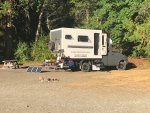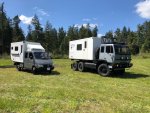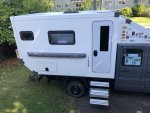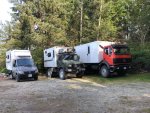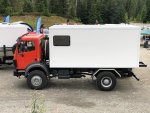Hey all - I've been lurking here for a while now, and this site is fantastic. Great community with lots of knowledgeable folks and rigs of all shapes and sizes.
I'm progressing from the wishing stage to the planning phase (aka "My wife now thinks building a rig is a good idea".). In this particular thread, I'm looking for input on choosing a base rig on which to build. Maybe some of the more grizzled veterans among you can dispense a few nuggets of wisdom to help point me in the right direction.
The goal is to make a truck with a composite camper box on it. Where I live in British Columbia, Canada, the traditional RV'ing season is short and the local selection of motorhomes if you want to go anywhere other than overbooked RV sites with paved access and power/sewer hookups is pretty marginal. Either the weather is too bad for them, or the roads are too rough. Or both.
The wife and I are too old for extended ground-sleeping and rooftop tent shenanigans, so I'm prepared to trade off hardcore rock-crawling trail capability for larger size with creature comforts. Still - we want to take the road less travelled, with the ability to stay off-grid for 1-2 weeks or more, rain or shine, sun or snow.
I'm not thrilled with the selection of larger N.American rough-duty truck manufacturers; fortunately here in Soviet Canuckistan we can legally import any vehicle more than 15 years old, and some of the all-wheel-drive Mercedes commercial trucks sold in Europe - and seemingly everywhere **except** N.America - have really caught my eye. Although they were never sold here new, they offer not-quite-Unimog levels of off-asphalt capability with (seemingly) much simpler drivetrain components. I have access to competent diesel truck mechanics shops, and Mercedes offers worldwide parts availability, so if something needs work, I'm hoping that I can find someone who can fix anything I can't do myself.
These trucks come in a bewildering array of shapes and sizes, and that's what brings me to this thread. Mercedes offerings range from 3-ton GVWR "Sprinter" vans up to 33-ton behemoths and beyond.
(A brief aside for those not familiar - Mercedes trucks are typically designated by their 3- or 4-digit code representing the max GVWR and engine rating. For example a "1124" is an 11-ton GVWR vehicle with a 240-hp engine).
One example used as build platforms in Europe are ex-fire-service 917 chassis, such as this one - 9-ton max GVWR and a 170-hp 5.9L OM352 diesel:
https://www.expeditionportal.com/forum/threads/overlander-interview-wolf-ilona-ogorek.11983/
Slightly beefier 1124 and 1224 ex-municipal rescue trucks also seem to be popular choices.
But after reading up on what this crazy Aussie built: http://www.robgray.com/ontheroad/wothahellizat/wot2/index.php , I'm not yet ruling out something larger - even a 6x6 monster like this: (Mercedes 2028A 6x6 ex-Bundeswehr in case the link to the ad eventually expires)
Naturally a bigger vehicle means bigger living space, greater carrying capacity for fluids, battery packs, bigger roof for solar panels, etc., etc. The 2028A is approx. 9 metres long overall, and has a nice 6.1m platform already in place to mount a box, plus extra room between it and the cab. All good stuff. (by comparison, the 917 overland rig with the composite shell camper is 7.3 metres long, and with that large rear overhang it is seemingly at the limits of its capacity)
But everything comes with trade-offs. Bigger means heavy! (although spread over 6 wheels, the 2028A weighs approx 11 tons completely empty - more than the previous 917 overland rig with camper and fully-loaded). Fortunately even the more remote areas where I live are accessible by Forestry Service Roads ("FSRs") which can handle fully-loaded logging trucks up to 63 metric tons, so weight itself shouldn't be an issue, and cargo trucks travel to even the most remote towns. Turning circles and getting stuck, however...
Big also means thirsty (that 280 hp on the 2028a comes from an enormous 14.6L diesel V8 - torquey and reliable, but I'm guessing 30-35 L/100 kms on a good day).
I understand that there is no such thing as the perfect rig for every and all conditions and situations, but for those of you out there with plus-sized rigs or who have spent time around them - any thoughts off the top of your heads? How big is too big? Anything I have completely failed to take into account?
As always - thanks in advance to anyone who takes the time to read and reply!
I'm progressing from the wishing stage to the planning phase (aka "My wife now thinks building a rig is a good idea".). In this particular thread, I'm looking for input on choosing a base rig on which to build. Maybe some of the more grizzled veterans among you can dispense a few nuggets of wisdom to help point me in the right direction.
The goal is to make a truck with a composite camper box on it. Where I live in British Columbia, Canada, the traditional RV'ing season is short and the local selection of motorhomes if you want to go anywhere other than overbooked RV sites with paved access and power/sewer hookups is pretty marginal. Either the weather is too bad for them, or the roads are too rough. Or both.
The wife and I are too old for extended ground-sleeping and rooftop tent shenanigans, so I'm prepared to trade off hardcore rock-crawling trail capability for larger size with creature comforts. Still - we want to take the road less travelled, with the ability to stay off-grid for 1-2 weeks or more, rain or shine, sun or snow.
I'm not thrilled with the selection of larger N.American rough-duty truck manufacturers; fortunately here in Soviet Canuckistan we can legally import any vehicle more than 15 years old, and some of the all-wheel-drive Mercedes commercial trucks sold in Europe - and seemingly everywhere **except** N.America - have really caught my eye. Although they were never sold here new, they offer not-quite-Unimog levels of off-asphalt capability with (seemingly) much simpler drivetrain components. I have access to competent diesel truck mechanics shops, and Mercedes offers worldwide parts availability, so if something needs work, I'm hoping that I can find someone who can fix anything I can't do myself.
These trucks come in a bewildering array of shapes and sizes, and that's what brings me to this thread. Mercedes offerings range from 3-ton GVWR "Sprinter" vans up to 33-ton behemoths and beyond.
(A brief aside for those not familiar - Mercedes trucks are typically designated by their 3- or 4-digit code representing the max GVWR and engine rating. For example a "1124" is an 11-ton GVWR vehicle with a 240-hp engine).
One example used as build platforms in Europe are ex-fire-service 917 chassis, such as this one - 9-ton max GVWR and a 170-hp 5.9L OM352 diesel:
https://www.expeditionportal.com/forum/threads/overlander-interview-wolf-ilona-ogorek.11983/
Slightly beefier 1124 and 1224 ex-municipal rescue trucks also seem to be popular choices.
But after reading up on what this crazy Aussie built: http://www.robgray.com/ontheroad/wothahellizat/wot2/index.php , I'm not yet ruling out something larger - even a 6x6 monster like this: (Mercedes 2028A 6x6 ex-Bundeswehr in case the link to the ad eventually expires)
Naturally a bigger vehicle means bigger living space, greater carrying capacity for fluids, battery packs, bigger roof for solar panels, etc., etc. The 2028A is approx. 9 metres long overall, and has a nice 6.1m platform already in place to mount a box, plus extra room between it and the cab. All good stuff. (by comparison, the 917 overland rig with the composite shell camper is 7.3 metres long, and with that large rear overhang it is seemingly at the limits of its capacity)
But everything comes with trade-offs. Bigger means heavy! (although spread over 6 wheels, the 2028A weighs approx 11 tons completely empty - more than the previous 917 overland rig with camper and fully-loaded). Fortunately even the more remote areas where I live are accessible by Forestry Service Roads ("FSRs") which can handle fully-loaded logging trucks up to 63 metric tons, so weight itself shouldn't be an issue, and cargo trucks travel to even the most remote towns. Turning circles and getting stuck, however...
Big also means thirsty (that 280 hp on the 2028a comes from an enormous 14.6L diesel V8 - torquey and reliable, but I'm guessing 30-35 L/100 kms on a good day).
I understand that there is no such thing as the perfect rig for every and all conditions and situations, but for those of you out there with plus-sized rigs or who have spent time around them - any thoughts off the top of your heads? How big is too big? Anything I have completely failed to take into account?
As always - thanks in advance to anyone who takes the time to read and reply!

